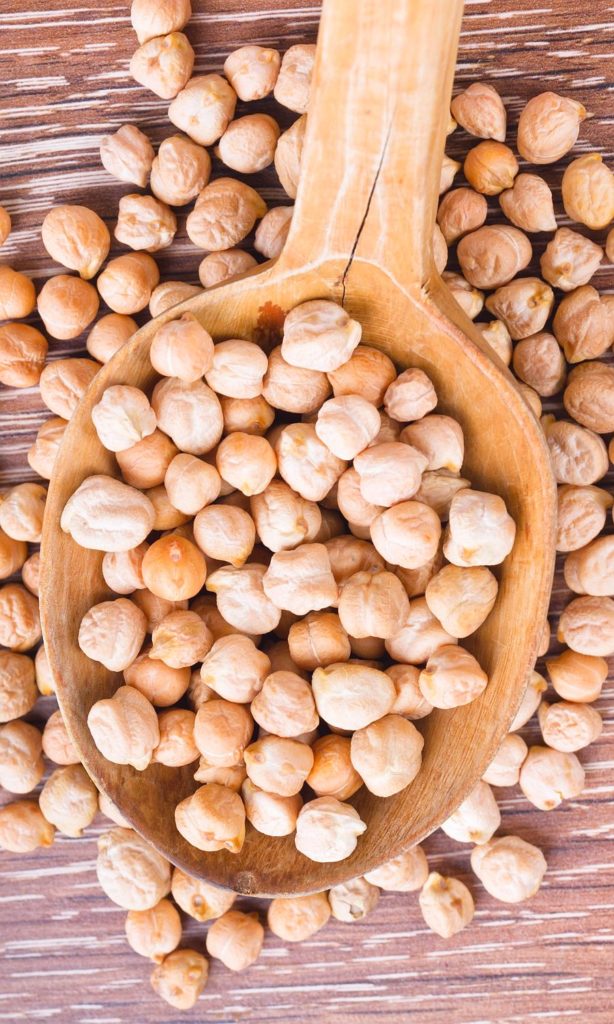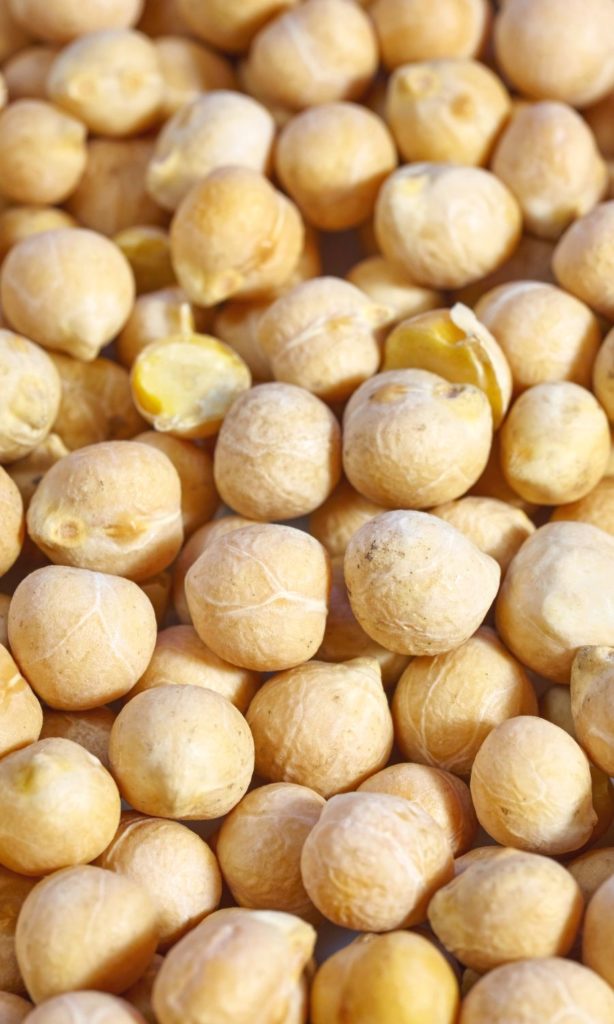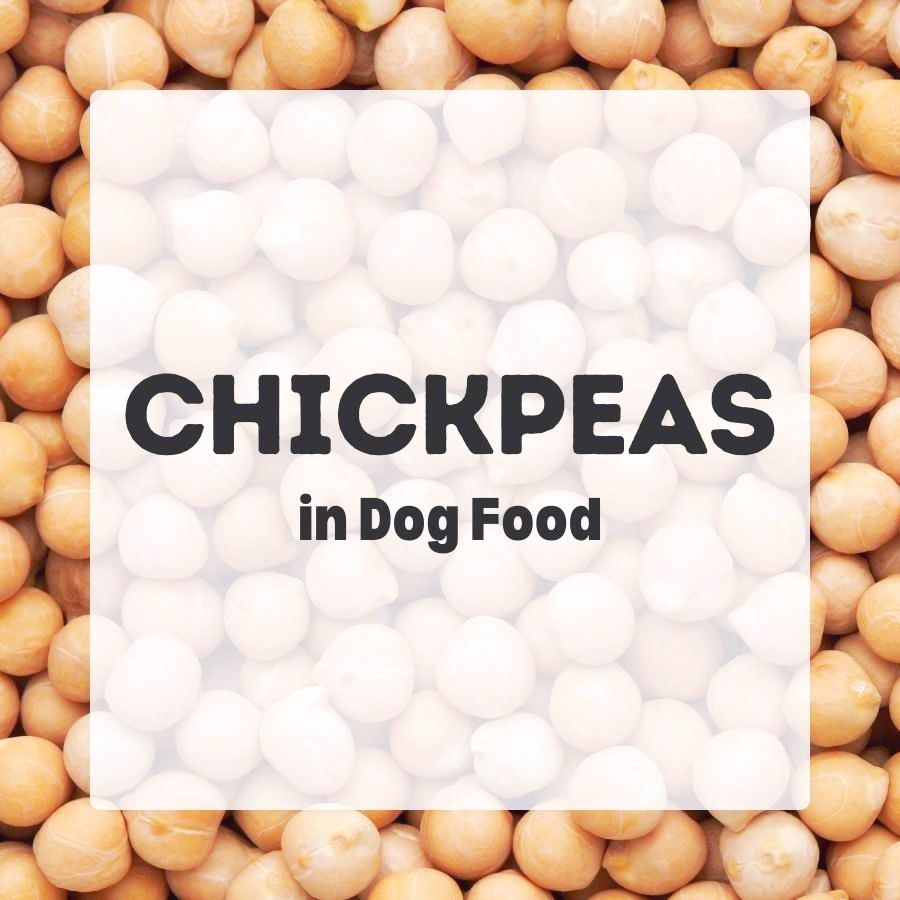Chickpeas or garbanzo beans in dog food are used as a novel source of plant-based proteins and carbohydrates.
Contents
What are Chickpeas?
Chickpeas (Cicer arietinum) are a type of legume that is commonly used in cooking and is popular around the world. They are a common ingredient in dishes like hummus or falafel.
Chickpeas and garbanzo beans are actually the same thing.

Like other pulse crops (beans, peas, or lentils) they have become popular in pet food as a multipurpose legume due to their carbohydrate and protein content.
Chickpeas have a nutty and creamy flavor and a slightly grainy texture. They can be consumed whole, split, or ground.
Garbanzo Beans in Dog Food
Garbanzo beans are a readily available pulse crop that has gained popularity as a plant-based protein source in the pet food industry.
Manufacturers mostly seem to use either use whole dried chickpeas/garbanzo beans or chickpea/garbanzo bean flour.

But are garbanzo beans healthy for dogs?
Chickpeas are a good source of protein, fiber, vitamins, and minerals, making them a nutritious addition to your pet’s diet[11].
They are low in fat but contain some unsaturated fatty acids and large amounts of starch making them a great source of energy.
Like in basically all legumes, their amino acid profile lacks sulfur-containing amino acids.
Although legumes have been used in dog food formulas for quite a while now (looking at you, soybean), the widespread and excessive use of pulses as major ingredients started only recently.
According to a 2020 pet food industry report, 15000 tons of garbanzo beans are used annually in pet food[1]. This makes chickpeas one of the most widely used novel “bean” ingredients.
Are Chickpeas Good For Dogs?
In moderation, chickpeas can be a good ingredient in dog food.
Dogs can digest chickpeas in dog food and use them as a source of nutrients[5]. They provide energy, are rich in plant-based protein, fiber, vitamins, and minerals, and are highly digestible for pets[3].
Legumes like chickpeas contain lots of bioactive phytochemicals. They also provide soluble fiber and complex carbohydrates, interesting e.g. for overweight or diabetic dogs[11].
However, they are often used in excess as a substitute for meat-based protein and carbohydrates in grain-free recipes.

Manufacturers like to highlight plant proteins as sustainable and eco-friendly alternatives to meat ingredients.
But they’re also much cheaper, whereas modern dog food recipes based on specialty ingredients usually aren’t, right? No wonder pet owners perceive legumes as low-quality fillers.
Dogs are omnivores and can thrive on many different ingredients as long as they get all the nutrients they need. But we still believe the proteins in a dog’s diet should mostly come from meat.
The protein quality of chickpeas is considered better than that of other pulses. However, chickpeas are generally low in threonine and methionine, amino acids essential for dogs[4,11].
Hence, garbanzo beans can’t provide a complete amino acid profile and need to be supplemented with other sources.
Like many legumes, raw chickpeas contain some anti-nutritional factors that can reduce their digestibility like enzyme inhibitors, alkaloids, tannins, phytic acid, saponins, or lectins[8,10,11].
But they need to be cooked or extruded to be edible to dogs anyway and this also gets rid of much of their problematic contents.

Chickpeas are a relatively new ingredient for dog foods.
Few studies have been done so far on the potential long-term effects of feeding chickpeas to dogs on a daily basis.
Chickpeas have been consumed for thousands of years as a cheap source of protein and other nutritional qualities.
But until recently we didn’t actually know all that about the nutrient composition & quality, or effects of dog food processing methods on their digestibility or nutrient profile.
Luckily, newer research indicates that chickpea carbohydrates and amino acids are indeed highly digestible for dogs[4,7].
But they are also high in slowly fermentable fiber and their inclusion can affect the fecal microbiome in dogs. And we don’t know yet if this has any implications for gut health[2,5].
There is some evidence to suggest that feeding dogs large amounts of legumes every day, including chickpeas, may be linked to diet-mediated heart problems in dogs.
The exact cause of dilated cardiomyopathy in dogs is not well understood. But recent research has suggested that certain diets (grain-free, high in legumes) may be contributing factors.
In conclusion, garbanzo beans are not dangerous for dogs.
But if they are used in huge quantities as the main source of protein and fed each and every day, they might be.
Like with all legumes, we recommend speaking to your veterinarian before adding them to your dog’s diet.
Further Reading
[1] Pet Food Production and Ingredient Analysis (PDF). 2020. Institute for Feed Education and Research (IFEEDER), North American Renderers Association (NARA), Pet Food Institute (PFI)
[2] Sandri et al. Substitution of a commercial diet with raw meat complemented with vegetable foods containing chickpeas or peas affects faecal microbiome in healthy dogs. Italian Journal of Animal Science. 2019. https://doi.org/10.1080/1828051X.2019.1645624
[3] Reilly et al. Evaluation of cooked and raw garbanzo beans as main plant protein sources in extruded feline diets. Journal of Animal Science. 2019. https://doi.org/10.1093/jas/skz258.131
[4] Reilly et al. Macronutrient composition, true metabolizable energy and amino acid digestibility, and indispensable amino acid scoring of pulse ingredients for use in canine and feline diets. Journal of Animal Science. 2020. https://doi.org/10.1093/jas/skaa149
[5] Traughber et al. Chemical Composition and In Vitro Fermentation Characteristics of Legumes Using Canine Fecal Inoculum. Journal of Animal Science. 2020. https://doi.org/10.1093/jas/skaa278.572
[6] Reilly et al. Use of legumes and yeast as main protein sources in extruded canine diets. Journal of Animal Science. 2019. https://doi.org/10.1093/jas/skz258.553
[7] Hsu et al. Evaluation of Extrusion Processing Method and Protein Source on Standardized Amino Acid Digestibility. Journal of Animal Science. 2021. https://doi.org/10.1093/jas/skab235.103
[8] Feedipedia: Chickpea (Cicer arietinum). 2015
[9] FAO 2017. Pulses and their by-products as animal feed (PDF). Chapter 7: Chickpeas.
[10] Bampidis & Christodoulou. Chickpeas (Cicer arietinum L.) in animal nutrition: A review. 2011. https://doi.org/10.1016/j.anifeedsci.2011.04.098
[11] Jukanti et al. Nutritional quality and health benefits of chickpea (Cicer arietinum L.): A review. British Journal of Nutrition. 2012. https://doi.org/10.1017/S0007114512000797
